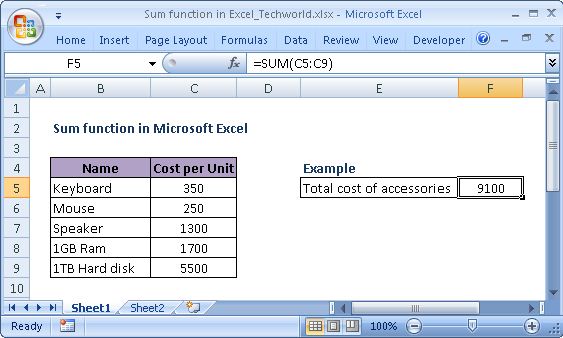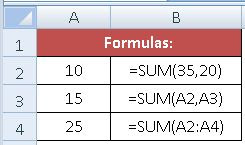Let's look at some Excel SUM function examples and explore how to use the SUM function as a worksheet function in Microsoft Excel:
Summary
SUM Function is a very popular and useful formula in Microsoft Excel. The SUM in Excel is a built-in function which adds all the numbers in the range of cells and returns the result of the addition. It is categorized as a Math/Trig Function in Excel.
SUM can handle up to 255 individual arguments, which can include numbers, cell references, ranges, arrays, and constants. As a worksheet function, the SUM function can be entered as part of a formula in a cell of a worksheet.
SUM can handle up to 255 individual arguments, which can include numbers, cell references, ranges, arrays, and constants. As a worksheet function, the SUM function can be entered as part of a formula in a cell of a worksheet.
Purpose
Add numbers together.
Return value
The sum of values supplied.
What Does It Do ?
- This function creates a total from a list of numbers.
- It can be used either horizontally or vertically.
- The numbers can be in single cells, ranges are from other functions.
Syntax
Sum function has two syntax's and hence they can be written in two different ways:
=SUM(Num1,Num2,...) or
=SUM(Range1,Range2,Range3... through to Range30)
=SUM(Num1,Num2,...) or
=SUM(Range1,Range2,Range3... through to Range30)
Parameters or Arguments
Number: A numeric value that you wish to sum.
Range: A group of cells that you wish to sum.
Range: A group of cells that you wish to sum.
Formatting
No special formatting is needed.
Usage notes
- Many people use the =SUM() function incorrectly.
- This example shows how the SUM has been combined with plus (+) symbols.
- The formula is actually doing more work than needed.
- It should have been entered as either =C48+C49+C50 or =SUM(C48:C50).
- Sum function can also do the addition of decimal numbers and fractions.
- The SUM function sums values supplied as arguments (up to 255 arguments).
- Arguments can be supplied as numbers, cell references, ranges, arrays, constants, and the results of other formulas or functions.
- If you are using SUM formula as =SUM( num1, num2, … num_n ) and in place of ‘num’ you have entered a non-numeric content then Sum function will throw an #Name? error.
- But if you are using SUM Function as =SUM ( Range1, Range2, … Range_n ) and if any of the cell range contains a non-numeric content then Sum function will ignore this value.
- For example, SUM(C1:C3) adds all the numbers that are contained in cells C1 through C3, which is equivalent to SUM (C1, C2, C3).
Shortcut for SUM Formula:
Instead for applying sum formula in the normal way, you can also apply the SUM Formula using a shortcut. Simply select the range (containing your numbers to be added), then press “Alt +” key and the desired sum will be populated in the next cell.
Excel Sum Function Examples
The following spreadsheet shows three simple examples of the Excel Sum function:
The above examples show that each argument to the Sum function can be supplied as a single value or cell reference, or as an array of values or cells.

.png)















No comments:
Post a Comment